Family Name: Onagraceae Jussieu
Synonym(s): Circaeaceae Bercht. & J. Presl; Epilobiaceae Vent.; Jussiaeaceae Martinov; Oenotheraceae C. C. Robin
Common Name(s): evening-primrose family
*Number of genera/species: 22/656
List of genera records in GRIN-Global
Fruit usually a loculicidal capsulecapsule:
a dry, dehiscent fruit derived from a compound ovary , sometimes indehiscentindehiscent:
, sometimes indehiscentindehiscent:
not opening on its own, as in a fruit
 and nut-like (Circaea, Oenothera spp.), rarely a berryberry:
and nut-like (Circaea, Oenothera spp.), rarely a berryberry:
an indehiscent, fleshy fruit with one or a few to many seeds. The flesh may be homogenous throughout. Or, if the outer part is hard, firm, or leathery, referred to as an hesperidium. Septa are present in some, and the seeds may be arillate or with a fleshy testa. (Fuchsia), 0.9–870 mm long, globoseglobose:
(Fuchsia), 0.9–870 mm long, globoseglobose:
3D shape—more or less spherical to sigmoid, tereteterete:
to sigmoid, tereteterete:
approximately circular in cross section; width and thickness approximately equal
 , flatted, or angledangular:
, flatted, or angledangular:
2D shape—having sides that meet at acute or obtuse angles
in transection, sometimes beakedbeak:
a usually firm, terminal appendage, sometimes tapered , sometimes 4-winged (Ludwigia spp., Oenothera spp., Tetrapteron), with one to few or many seeds, calyxcalyx:
, sometimes 4-winged (Ludwigia spp., Oenothera spp., Tetrapteron), with one to few or many seeds, calyxcalyx:
the outer whorl of the perianth; all the sepals of a flower sometimes persistent. Pericarppericarp:
sometimes persistent. Pericarppericarp:
fruit wall or fruit coat
black, purple, green, brown, yellow, or red, sometimes flecked or streaked, dulldull:
reflecting only a low proportion of incident light, with no apparent sheen , shinyshiny:
, shinyshiny:
uniformly reflecting a high proportion of incident light at all angles , or glaucous, thin- or thick-walled, paperypapery:
, or glaucous, thin- or thick-walled, paperypapery:
texture—papyraceous, chartaceous; very thin, pliable, and readily torn; like paper
, woodywoody:
texture—consisting mainly of indurate lignified tissues, characteristic of or resembling wood
, leatheryleathery:
texture—moderately thick, tough, and very pliable
, corkycorky:
firm, relatively light, discontinuous but strongly cohesive, and resilient
, or fleshy, glabrousglabrous:
without hairs
or pubescentpubescent:
surface relief—bearing hairs
, including glandularglandular:
surface relief—covered with small, raised secretory glands, regular or irregularly shaped, translucent or opaque, and maybe distinctly colored , smooth or toruloseknotted:
, smooth or toruloseknotted:
3D shape—a cylindrical or ellipsoid body that is swollen and constricted at intervals; torulose , striatestriate:
, striatestriate:
surface relief—having fine, parallel lines, grooves or ridges , ribbedribbed:
, ribbedribbed:
surface relief—wide, prominent, linear ridges that are generally rounded and longitudinally situated on the surface , groovedgrooved:
, groovedgrooved:
surface relief—linear depressions that may be single or form a series of grooves over the surface , sulcatesulcate:
, sulcatesulcate:
surface relief—having one or more elongate, relatively narrow and shallow depressions or grooves , wrinkledwrinkled:
, wrinkledwrinkled:
surface relief—shallow, irregular folds and furrows covering the surface; appearing overall though crumpled and then spread out , wartywarty:
, wartywarty:
surface relief—distinct, rounded projections that are large relative to the fruit size; tuberculate, verrucose , reticulatereticulate:
, reticulatereticulate:
surface relief—netted, raised walls or concave grooves forming a net-like surface pattern with flat, concave, or convex interspaces , with hornshorn:
, with hornshorn:
a straight or curved, slenderly conic or conoidal protrusion, resembling an animal horn
. Gongylocarpus fruits are indehiscentindehiscent:
not opening on its own, as in a fruit
 , hardened, irregular or diamond shaped, and embedded in stems below the flowering nodes. Fruits are released as stem disintegrates.
, hardened, irregular or diamond shaped, and embedded in stems below the flowering nodes. Fruits are released as stem disintegrates.
Seeds globoseglobose:
3D shape—more or less spherical to rhombicrhombic:
to rhombicrhombic:
2D shape—diamond-shaped in outline; having the form of a rhombus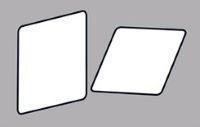 , tereteterete:
, tereteterete:
approximately circular in cross section; width and thickness approximately equal
 , flattened, or triangulartriangular:
, flattened, or triangulartriangular:
2D shape—three relatively straight sides with distinct corners; more angular than teardrop-shaped in transection, 0.1–6 mm long (with wings to 14 mm long). Wings sometimes present at one end or encircling a seed. Seed coat gray, black, purple, green, brown, yellow, or red, sometimes mottledmottled:
in transection, 0.1–6 mm long (with wings to 14 mm long). Wings sometimes present at one end or encircling a seed. Seed coat gray, black, purple, green, brown, yellow, or red, sometimes mottledmottled:
with colored spots, streaks, or blotches of a different color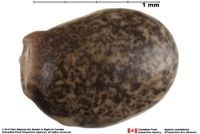 or spotted, dulldull:
or spotted, dulldull:
reflecting only a low proportion of incident light, with no apparent sheen or shinyshiny:
or shinyshiny:
uniformly reflecting a high proportion of incident light at all angles , crustaceouscrustaceous:
, crustaceouscrustaceous:
texture—thin, dry, indurate, and brittle
or membranousmembranous:
texture—extremely thin, pliable, and fairly tough
, smooth or sculptured, glabrousglabrous:
without hairs
or pubescentpubescent:
surface relief—bearing hairs
. Hila punctate. Chamaenerion and Epilobium seeds usually with a persistent (deciduousdeciduous:
falling off; not persistent
in Epilobium spp.) tuft of long white, yellowish, tawnytawny:
brownish-yellow; tan
, or reddish hairs at chalazalchalaza:
the region at the base of the ovule where the integuments are inserted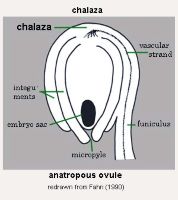 end and chalazalchalaza:
end and chalazalchalaza:
the region at the base of the ovule where the integuments are inserted with inconspicuous or conspicuous collar.
with inconspicuous or conspicuous collar.
Embryo well developed, completely filling seed cavity, foliatefoliate:
appearing leaf-like
or linearlinear:
(shape) long, narrow, and uniform in width; (of embryo) embryo is straight and much longer than wide , straight or bentbent:
, straight or bentbent:
(of embryo) embryo is bent at an acute, V-shaped angle with the ends close together and generally thick cotyledons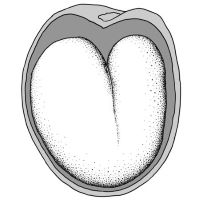 , with investinginvesting:
, with investinginvesting:
(of embryo) embryo is nearly or completely filling seed coat, straight, and axile and centric with spatulate cotyledons and covering the stalk for at least half its length; (of cotyledons) cotyledons spatulate and covering the stalk for at least half its length
or spatulatespatulate:
2D shape—like a spatula; rounded at the apex, with base long and tapered; (of embryo) embryo is straight and axile and centric with the cotyledons expanded to form the shape of a spatula or spoon; (of cotyledons) cotyledons expanded and wider than the stalk but not invested into the stalk cotyledons.
cotyledons.
Endosperm scanty.
| Fruit | |
| Type | loculicidalloculicidal: type of capsular dehiscence, opening longitudinally through the locules (compare septicidal)  capsulecapsule: capsulecapsule:a dry, dehiscent fruit derived from a compound ovary  , sometimes nut-like, rarely berry , sometimes nut-like, rarely berry |
| Size range | 0.9–870 mm long |
| Shape(s) | globoseglobose: 3D shape—more or less spherical  , ellipsoidalellipsoid: , ellipsoidalellipsoid:3D shape—elliptic , fusiformfusiform: spindle-shaped; broadest at the middle and tapering at both ends  , oblongoblong: , oblongoblong:2D shape—much longer than broad with nearly parallel sides, corners are rounded  , cylindricalcylindrical: , cylindricalcylindrical:3D shape—a cylinder, with parallel sides and a circular cross-section; tubular or rod-shaped , lanceoloidlanceoloid: 3D shape—lanceolate , clavateclavate: 3D shape—club-shaped, with attachment at or near narrow end (compare obclavate)  , pyramidalpyramidal: , pyramidalpyramidal:3D shape—pyramid-shaped (compare obpyramidal) 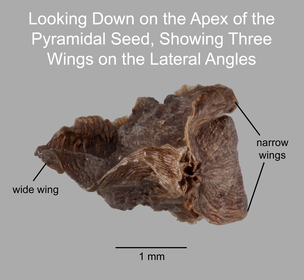 , rhomboid, quadrangularquadrangular: , rhomboid, quadrangularquadrangular:2D shape—four-sided, as in a square or rectangle 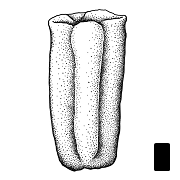 , angledangular: , angledangular:2D shape—having sides that meet at acute or obtuse angles , falcatefalcate: shaped like a scythe or sickle  , sigmoid , sigmoid |
| Texture | thin- or thick-walled, paperypapery: texture—papyraceous, chartaceous; very thin, pliable, and readily torn; like paper , woodywoody: texture—consisting mainly of indurate lignified tissues, characteristic of or resembling wood , leatheryleathery: texture—moderately thick, tough, and very pliable , corkycorky: firm, relatively light, discontinuous but strongly cohesive, and resilient , fleshy |
| Surface relief | smooth, toruloseknotted: 3D shape—a cylindrical or ellipsoid body that is swollen and constricted at intervals; torulose  , striatestriate: , striatestriate:surface relief—having fine, parallel lines, grooves or ridges  , ribbedribbed: , ribbedribbed:surface relief—wide, prominent, linear ridges that are generally rounded and longitudinally situated on the surface  , groovedgrooved: , groovedgrooved:surface relief—linear depressions that may be single or form a series of grooves over the surface  , sulcatesulcate: , sulcatesulcate:surface relief—having one or more elongate, relatively narrow and shallow depressions or grooves  , wrinkledwrinkled: , wrinkledwrinkled:surface relief—shallow, irregular folds and furrows covering the surface; appearing overall though crumpled and then spread out  , wartywarty: , wartywarty:surface relief—distinct, rounded projections that are large relative to the fruit size; tuberculate, verrucose  , reticulatereticulate: , reticulatereticulate:surface relief—netted, raised walls or concave grooves forming a net-like surface pattern with flat, concave, or convex interspaces  , with hornshorn: , with hornshorn:a straight or curved, slenderly conic or conoidal protrusion, resembling an animal horn |
| Color(s) | black, purple, green, brown, yellow, red, sometimes flecked or streaked |
| Seed | |
| Size range | 0.1–6 mm long (with wings to 14 mm long) |
| Shape(s) | globoseglobose: 3D shape—more or less spherical  , lens-shapedlens-shaped: , lens-shapedlens-shaped:2D shape—round and flattened with two curved (convex) surfaces , ellipsoidellipsoid: 3D shape—elliptic , oblongoblong: 2D shape—much longer than broad with nearly parallel sides, corners are rounded  , fusiformfusiform: , fusiformfusiform:spindle-shaped; broadest at the middle and tapering at both ends  , obovoidobovoid: , obovoidobovoid:3D shape—obovate , clavateclavate: 3D shape—club-shaped, with attachment at or near narrow end (compare obclavate)  , oblanceoloid, cuneiformcuneiform: , oblanceoloid, cuneiformcuneiform:wedge-shaped , triangulartriangular: 2D shape—three relatively straight sides with distinct corners; more angular than teardrop-shaped  , reniformreniform: , reniformreniform:2D or 3D shape—kidney-shaped  , angledangular: , angledangular:2D shape—having sides that meet at acute or obtuse angles , rhombicrhombic: 2D shape—diamond-shaped in outline; having the form of a rhombus  |
| Surface relief | smooth, striatestriate: surface relief—having fine, parallel lines, grooves or ridges  , ribbedribbed: , ribbedribbed:surface relief—wide, prominent, linear ridges that are generally rounded and longitudinally situated on the surface  , ridgedridged: , ridgedridged:surface relief—raised, thick ridges, sharp edged or rounded, usually in a series that may cover the entire surface  , pittedpitted: , pittedpitted:surface relief—surface with small depressions in which the areas between the hollows do not take on the appearance of a true reticular net  , wrinkledwrinkled: , wrinkledwrinkled:surface relief—shallow, irregular folds and furrows covering the surface; appearing overall though crumpled and then spread out  , papillosepapillate: , papillosepapillate:surface relief—bearing minute, distinct, broad-based projections, tapering to a rounded apex  , wartywarty: , wartywarty:surface relief—distinct, rounded projections that are large relative to the fruit size; tuberculate, verrucose  , bubbled, shaggy, scalyscaly: , bubbled, shaggy, scalyscaly:surface relief—covered with small, thin, fine scales or flakes that may be removable 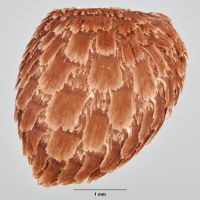 , or with cavity or conspicuous grove , or with cavity or conspicuous grove |
| Color(s) | gray, black, purple, green, brown, yellow, red, sometimes mottledmottled: with colored spots, streaks, or blotches of a different color  or spotted or spotted |
| Other | |
| Embryo | well-developed, completely filling seed cavity, foliatefoliate: appearing leaf-like or linearlinear: (shape) long, narrow, and uniform in width; (of embryo) embryo is straight and much longer than wide  , straight or bentbent: , straight or bentbent:(of embryo) embryo is bent at an acute, V-shaped angle with the ends close together and generally thick cotyledons  , with investinginvesting: , with investinginvesting:(of embryo) embryo is nearly or completely filling seed coat, straight, and axile and centric with spatulate cotyledons and covering the stalk for at least half its length; (of cotyledons) cotyledons spatulate and covering the stalk for at least half its length or spatulatespatulate: 2D shape—like a spatula; rounded at the apex, with base long and tapered; (of embryo) embryo is straight and axile and centric with the cotyledons expanded to form the shape of a spatula or spoon; (of cotyledons) cotyledons expanded and wider than the stalk but not invested into the stalk  cotyledons cotyledons |
| Nutritive tissue | endosperm scanty |
Nearly worldwide distribution
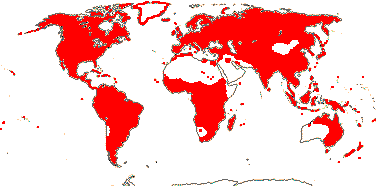
Distribution map courtesy of Angiosperm Phylogeny Website.
Flora of North America Editorial Committee 1993+Flora of North America Editorial Committee 1993+:
Flora of North America Editorial Committee, eds. 1993+. Flora of North America North of Mexico [Online]. 22+ vols. Flora of North America Association, New York and Oxford. Accessed January-March 2024. URL: http://beta.floranorthamerica.org.; Kirkbride et al. 2006Kirkbride et al. 2006:
Kirkbride JH, Jr, Gunn CR, and Dallwitz MJ. 2006. Family guide for fruits and seeds, vers. 1.0. Accessed September 2020-January 2022. URL: https://nt.ars-grin.gov/seedsfruits/keys/frsdfam/index.cfm .; Munz 1960Munz 1960:
Munz PA. 1960. The genus Hauya (Onagraceae). Aliso: A Journal of Systematic and Floristic Botany 4: 492–499. https://scholarship.claremont.edu/aliso/vol4/iss3/6; Takhtajan 2009Takhtajan 2009:
Takhtajan A. 2009. Flowering plants: Second edition. Springer Nature, Switzerland. 871 pp.; Wagner and Hoch 2005 onwardsWagner and Hoch 2005 onwards:
Wagner WL and Hoch PC. 2005 onwards. Onagraceae, The Evening Primrose Family website. Accessed January 2024. URL: http://botany.si.edu/onagraceae/index.cfm
*The number of genera and species is based on Christenhusz and Byng 2016Christenhusz and Byng 2016:
Christenhusz MJM and Byng JW. 2016. The number of known plant species in the world and its annual increase. Phytotaxa 261 (3): 201-217. https://doi.org/10.11646/phytotaxa.261.3.1, which may differ from the number of genera in GRIN-Global.